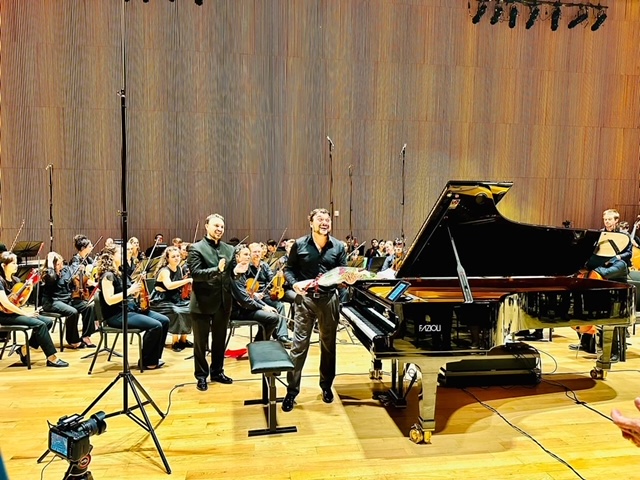Jinyoung Park Kim, Viola; Sonja Park, Piano
Weill Recital Hall at Carnegie Hall, New York, NY
November 17, 2024
Something special often happens when family members perform together, and a Sunday concert by sisters Jinyoung Park Kim, violist, and Sonja Park, pianist, supported that generalization. There were many moments of oneness, and a warmth of spirit pervaded Weill Hall. Presented by Mannes Prep, where Jinyoung Park Kim teaches, this sold-out concert had a refreshingly large contingent of excited young listeners, many seeming to know one another and some bearing flowers.
This concert was described in the violist’s notes as “a special reunion for Ms. Park Kim as she joins her sister, pianist Sonja Park, on stage.” Indeed, considering that Ms. Park’s piano career in recent years has been based in Doha, Qatar, one guesses that playing together has probably been inconvenient, to say the least; if rehearsals were at all scarce, however, their individual professionalism paired with family bonds carried the day. Both musicians have biographies filled with numerous awards, accolades, and international performances, and both have been instrumental (pun intended) in supporting and cultivating young talent in classical music.
The program was billed fancifully as “Romantic Reveries” – with “Romantic” clearly not referring to the historical era, as the program opened with a viola version of Bach’s Cello Suite No. 3 in C major (BWV 1009); Ms. Kim, however, did take a somewhat Romantic approach in her rendition of this much-loved suite. (This reviewer would opt for that any day over some of the fustiness we sometimes hear in the name of historical fidelity.) Her opening Prelude unfolded expansively, with no taint of the metronome about it but rather some welcome agogics gently emphasizing important metric and cadential points. Her tone was full, warm, and focused. The whole suite was finished in a flash due to the avoidance of repeats (perhaps a decision made with the younger audience members in mind), but a repeat of the first section of the Sarabande allowed some judicious embellishment, and naturally there was the built-in repeat of Bourrée I after Bourrée II. Many would argue against the condensing of such a great work, but this is not the forum for such involved debate; furthermore, those working with the young these days and having to compete with smartphones for attention must follow their own instincts. The audience – of all ages – was rapt. Ms. Kim’s Gigue simply danced, closing the set with joy.
Music from the actual Romantic era followed as Ms. Kim and Ms. Park joined forces for the Brahms Sonata in E-flat, Op. 120, No. 2. Originally composed for clarinet after being inspired by the great clarinetist Richard Mühlfeld, the viola version was said to have left the composer with some doubts (not unusual, as Brahms excelled in the department of doubt); we mere mortals, however, are grateful for the increased hearings afforded by this version (as well as other versions). One challenge, though, in performing such a clarinet work with viola involves adjusting the balance given the more contrasting timbres, but fortunately, even with the highly resonant hall Steinway (with the lid wisely set on the half-stick), the viola was never overpowered. One could guess how much restraint was being used overall from the way the piano’s sound penetrated during solo passages.
All in all, the Park-Kim duo projected a strong feeling for this mature and soulful work. Memorable moments included the seamless exchange within phrases in the opening Allegro amabile movement, where one heard the musical equivalent of the two sisters finishing each other’s sentences. Also memorable, in the second movement’s central B-major section, was the way they captured the composer’s characteristic nobility, with Ms. Park setting the tone perfectly. They impressed throughout with their split-second reactions, and in tricky ensemble passages one couldn’t help noticing that the two seemed to need no cues. Plenty were given (even if in a vestigial sort of way), but those seemed more coincidental than causal, as there was already a mutuality verging on telepathy (more effective than nods or gestures)!
After intermission, Ms. Park played two solo piano works, first the Gershwin-Wild Embraceable You and then the Schumann-Liszt Widmung (“Dedication”) in a switch of order from the printed program. On the subject of the printed program itself, this reviewer was surprised to see Embraceable You listed solely as Gershwin. For such music, where more than a workaday arrangement has been made, it seems remiss not to list the arranger/transcriber, in this instance, the late Earl Wild, whose inspired piano version has quite a following. In any case, both transcriptions seemed well-suited to this pianist’s penchant for “romantic reverie” – and, aside from a few minor snags that were well-handled, they were both quite lovely. (To this listener, there could have been more time given to the final Ave Maria section at the end, but Vive la différence!)
The high point of this well-paced program came next in a set of seven pieces from the ballet Romeo and Juliet by Prokofiev, arranged for viola and piano – again with an unlisted transcriber, though one is almost certain that it was Vadim Borisovsky. Crediting aside, the duo took this dazzling set through a panoramic journey, starting with its meditative Introduction. They continued theirride through the jaunty pizzicati and harmonics of The Street Awakens and thefeverish energy of Juliet the Young Girl. The famous Dance of the Knights, with its hair-raising viola octaves and stomping piano bass, emerged as epic, and Mercutio, which followed, had just the right wild athleticism. The Balcony Scene and the Death of Juliet brought the program to an emotionally stirring close, with the only signs of fatigue being a minor intonation glitch or two, but those somehow even added further to the pathos of it all. The entranced audience gave a standing ovation.
Encores included a touching Romance by Sang Jin Kim and – if one heard correctly in the noisy hall – a hymn arrangement made especially for them by James Ra.










